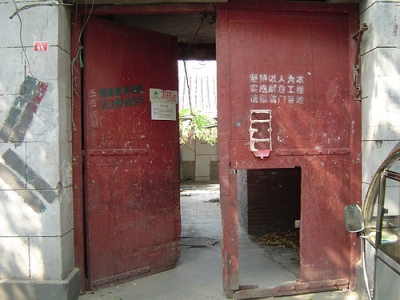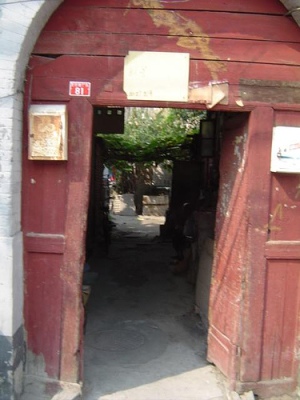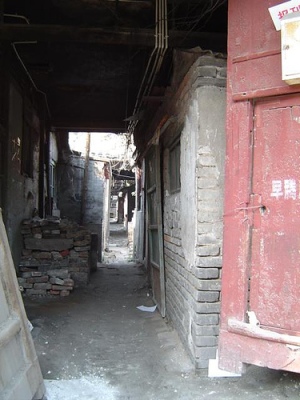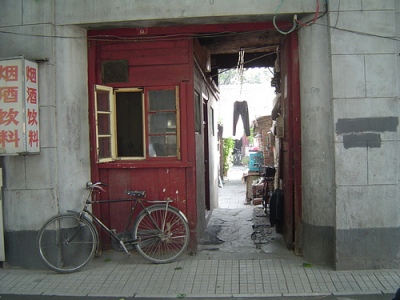Central Beijing used to be filled with hutong—single story courtyard homes on narrow lanes. They started in the Yuan dynasty (1279-1368) but the current structures mostly date from the earlier part of the Qing Dynasty (1644-1911).
Expansive compounds, where several branches of the same family had multiple courtyards have since been divided and subdivided into small, cramped apartments. The hutong neighborhoods are known for their communities and for their historic architecture.
They’re also known because the Beijing government is using eminent domain and razing large swaths of them in order to build fancy high rises in their quest to become a modern metropolis.
China watchers mourn the loss of Beijing’s old-world charm.
Lonely Planet: China (2008) says:
“Hutong may still be the stamping ground of a quarter of Beijing’s residents, but many are sadly being swept aside in Beijing’s race to manufacture a modern city of white tile high-rises. Marked with white plaques, historic homes are protected, but for many others a way of life hangs precariously in the balance… Old walled courtyards are the building blocks of this delightful world. Many are still lived in and hum with activity. From spring to autumn, men collect outside their gates, drinking beer, playing chess, smoking and chewing the fat. Inside, trees soar aloft, providing shade and a nesting ground for birds.”
It of course, glosses over the extreme (but picturesque!) poverty of the situation:
“Foreigners long ago cottoned on to the charm of courtyards and breached this very conservative bastion; however, many have been repelled by poor heating, no hot water, no cable TV, dodgy sanitation and no place to park the SUV. Many hutong homes still lack toilets, which explains the multitude on malodorous public loos stung out along the alleyways”
Hutong are heated by burning coal honeycombs on the stove. They lack plumbing—communal bathrooms are located every few blocks. And, with how ownership and usage rights are assigned and controlled, residents have had no incentive in the last century to maintain their houses. Let’s face it—a house that is over two hundred years old needs a lot of upkeep.
The hutong neighborhoods are Beijing’s slums and their most ardent defenders are tourists and scholars who like to visit but do not live their. A sad part of me thinks that maybe this people don’t mourn the hutong, but instead mourn China’s place as an exotic backwater.
In his book, The Last Days of Old Beijing, hutong resident Michael Meyer outlines both sides of the argument, torn on what is best for Beijing and what is best for the neighborhood he lives in, his friends, his students, and his community. He doesn’t gloss over the poverty of the place (lots of descriptions of taking a soda bottle filled with urine to the toilet every morning, and his freezing because he’s afraid of asphyxiating if he burns coal like his neighbors), but Meyer loves his neighborhood, and eloquently defends it:
“Outsiders often called the hutong slums, but the neighborhood did not cause pathologies or problematic behavior. Our neighborhood was not a pit of despair; you heard laughter and lively talk and occasionally, rears and arguments, just like anywhere else. People treated each other with something I missed the minute I set foot outside the hutong: civility. Residents recognized each other, so there was no cursing or name-calling directed at anonymous faces, without repercussions. Cars could not blare the horn, cut your off, and motor away. In the lanes, belligerence was not a virtue, tolerance was. Strangers knew they were guests, not authorities.”
A changing city is never easy, and we all mourn the loss of something we love. And, even though when the central capital has the same housing plan as rural villages, you have some usage issues, I doubt you will be surprised to learn that China is handling the entire situation extremely poorly.
Residents wake up in the morning to find the demolish notice spray painted on the wall. They are given a settlement that will buy them an apartment far from the city center. Corruption in the process means many residents never get their money at all. There is no one to appeal to. There is no transparency. Part of Peter Hessler’s Oracle Bones details the futile fight of one couple to save their home.
Neighborhoods and communities that have been together for decades, are scattered overnight. They survived the tumultuous events of the twentieth century, but they didn’t stand a chance against China’s rush to the future. Tearing the hutong down and putting new construction on top is much cheaper than restoring and renovating the centuries-old structures.
There is also, often, an age gap in the hutong debate within the neighborhoods itself—residents who have lived there for half a century or more are (understandably) loathe to leave. Younger residents want to live in the shiny new buildings that, to them, often herald progress.
Walking through central Beijing, one can see, first hand, the frenzied rush of China’s new economy. Crumbling hutong sit next to soaring skyscrapers. The small lanes suddenly spill into large thoroughfares.
But it is more than the loss of the hutong, it is the loss of the soul of Beijing as it takes on the globalized homogenized way of urban life. As Beijing loses its historic neighborhoods, it’s also losing its fabled 600 local snacks. In the rush to reinvent themselves for the future, there is a sense that the city is forgetting what it was in the past, except for the spots that bring in the tourist dollars. China destroyed so much of its ancient history during the first decades of Communism. It has since rebuilt much of it. The remnants of the Ming Dynasty Beijing city wall at Chongwenmen was destroyed in the 1950s and 1960s. Later the city regretted it and residents were forced to return the bricks to rebuild the wall. There are no easy answers about what to do with the hutong, but in a country that has come to regret so much of what it has destroyed, one would hope it would think more carefully about destroying the originals that it still has left.
Pictures were all taken by me in September 2007. We stayed in a hotel that had been built over a razed neighborhood a few miles from this one. Before his house was destroyed to build shiny shopping centers and hotels, a resident wrote the following on his wall:
Poor in the carefree city/ there is no quarter/ Prosperity is in the remote mountains/ Where I know people who care.



Yay, I’m glad you got to finish this post! (I saw it sitting in the Drafts folder, but I was a good admin and didn’t read it ahead of time, so as not to spoil the surprise.) I didn’t actually get a chance to see a hutong neighborhood when I was in China this past summer, so it’s interesting to hear your more first-hand impressions of the whole issue. Given all the manpower China has shown itself willing to devote to building projects recently, I can only imagine what the hutong neighborhoods would turn into if they felt like updating/restoring them. But as you said, and as people seem to find in the US, too, the tear down a rebuild approach often seems easier.
The juxtaposition of old and new is something Hilary actually just recently touched on over at Less Than a Shoestring too.
It’s not just easier, tearing down and building something new is much less expensive AND yields a huge profit.
And, there is a space-usage issue–central Beijing really shouldn’t have the same layout as a rural village.
BUT! It’s so hard to watch your city and neighborhood change. And there’s a fine line that needs to be walked between moving ahead and staying anchored to your roots–Beijing isn’t walking that line very well.
Plus there’s also the issue that even if they did restore the hutongs, then they’d become trendy historical districts that would be really expensive to live in, and all the people in them now would still have to move to the new, far away high rises.
In Lijiang, they turned the entire “Old Town” area of courtyard houses into shopping, restaurants, and guest houses, and moved all the residents to the apartment buildings known as “New Old Town.” In that case, though, they claimed it was because Old Town wasn’t safe from earthquakes, so for everyone’s safety they had to move… and then they turned the dangerous area into the biggest tourist area in the region.
Right, and a lot of the people who live there don’t have ownership rights, many only have usage rights, many rent from whomever has the usage rights. Many residents are still in the hutong after being assigned housing there in the early days of Communism. Rents are really, really low (like, under 20 yuan a month low) for many residents.
The hutongs that have been saved an renovated are now all high-end boutique hotels that I couldn’t afford to stay in last fall